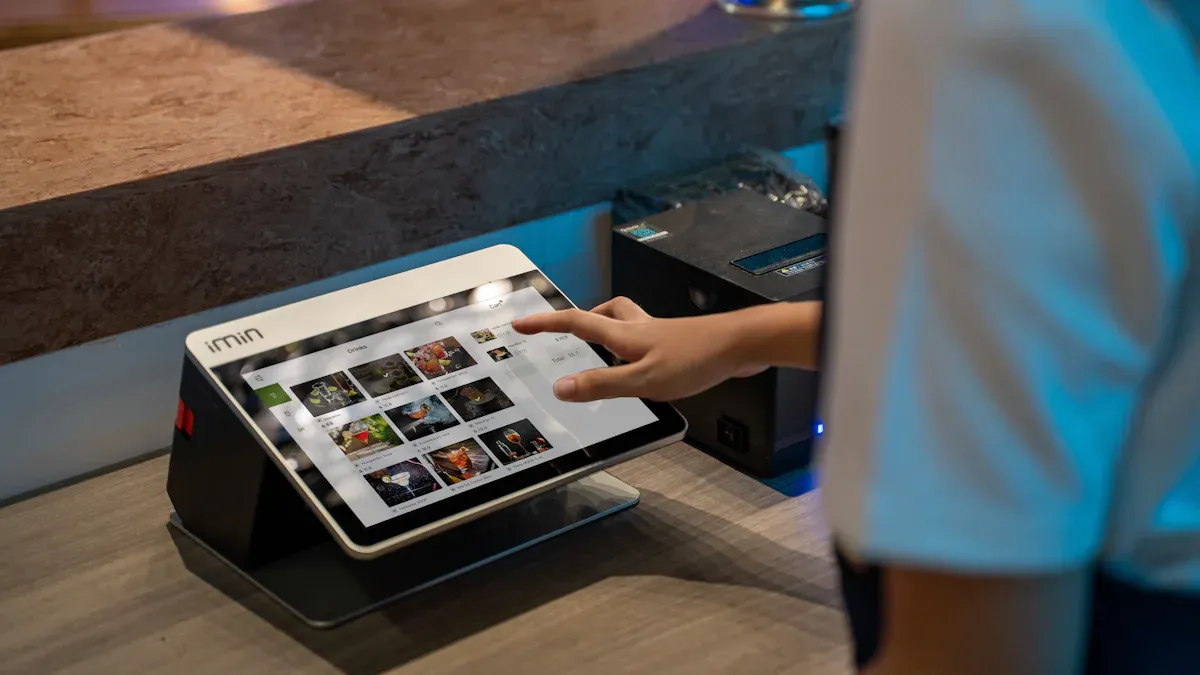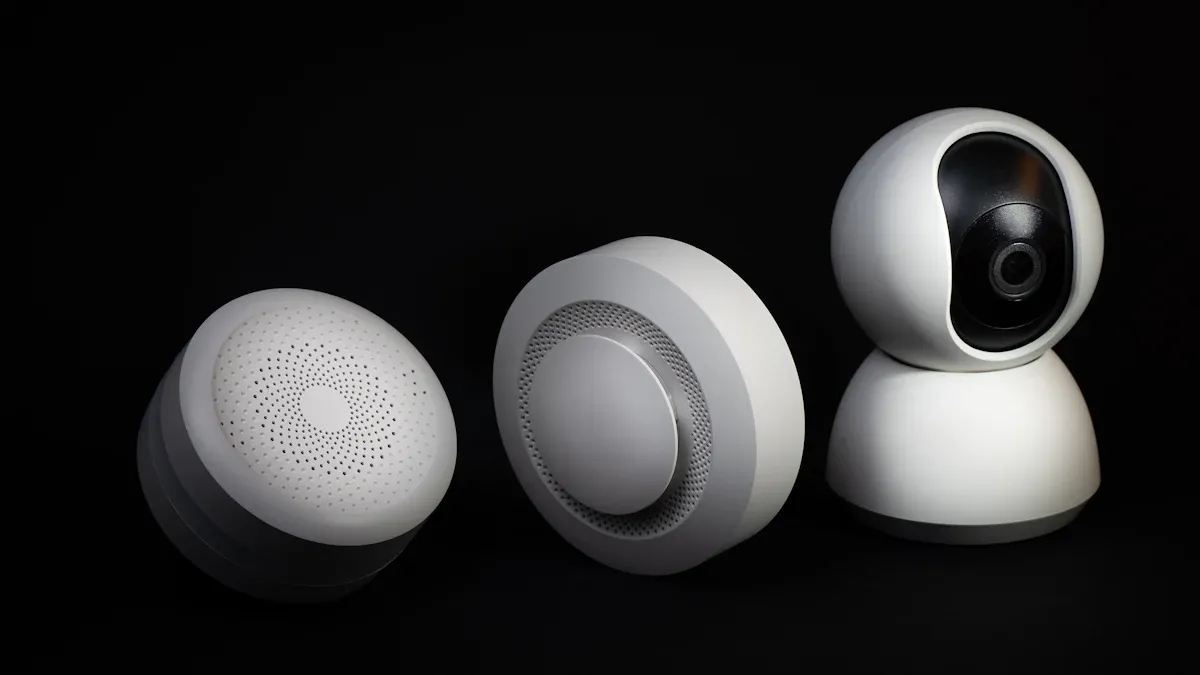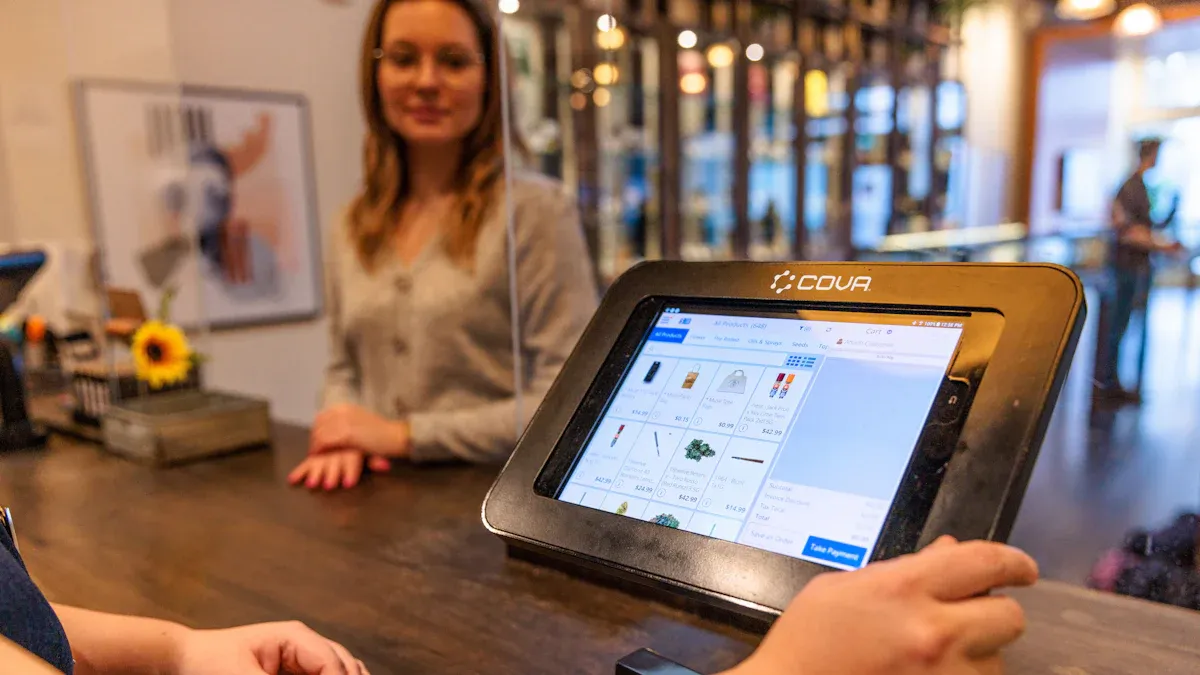Sensor fusion retail checkout system

A sensor fusion retail checkout system uses different sensors to help you check out without waiting in line. You see cameras, RFID tags, and weight sensors working together to track items as you shop. This system gives you a fast and smooth experience. It helps stores reduce errors and save money. Sensor fusion combines data from many sources, making shopping easier and more accurate for you.
Key Takeaways
Sensor fusion retail checkout systems use cameras, RFID tags, and weight sensors to track items automatically, making shopping faster and easier.
These systems eliminate long checkout lines by charging your account as you leave the store, enhancing your shopping experience.
Real-time data processing ensures high accuracy in tracking purchases, reducing errors and saving stores money.
Artificial intelligence and computer vision improve inventory management and customer insights, leading to better service and satisfaction.
Implementing a sensor fusion system requires careful planning, integration, and staff training to ensure a smooth transition and successful operation.
How sensor fusion works

Sensor integration
When you walk into a store with a sensor fusion retail checkout system, you interact with several types of technology. These systems use cameras, RFID tags, and weight sensors to track every item you pick up or put back. Each sensor has a special job:
Technology | Function |
|---|---|
RFID | Tracks inventory without needing a direct line of sight, enabling quick stock audits. |
Weight Sensors | Detects changes in shelf weight to determine how many items have been added or removed. |
Cameras | Identifies products and detects misplaced items, enhancing inventory accuracy. |
You might notice that cameras watch the shelves and aisles. They can spot when an item is missing or moved. RFID tags, which are tiny chips attached to products, let the system know exactly which item leaves the shelf. Weight sensors under the shelves measure changes, so the system knows how many items you take or return. When these sensors work together, they create a complete picture of your shopping activity.
Tip: The combination of these sensors means you do not need to scan each item. The system updates your virtual cart automatically, making shopping faster and easier.
Real-time processing
Sensor fusion does not just collect data; it processes everything instantly. As you shop, the system uses computer vision and deep learning algorithms to recognize products and track your movements. This technology can:
Detect when you pick up or put back an item.
Match the item to your virtual cart.
Track who took what, even in a busy store.
Here are the main components that make this possible:
Component | Description |
|---|---|
Computer Vision | Enables detection and identification of items picked up by customers using cameras and algorithms. |
Sensor Fusion | Tracks customer and item movement using various sensors, combining data for accurate tracking. |
Deep Learning Algorithms | Trained to identify a wide range of products and prevent theft by analyzing item movement. |
Artificial intelligence plays a big role in this process. It helps the system spot patterns, prevent theft, and keep inventory records up to date. For example, AI can watch for low stock levels and alert staff to restock shelves. Machine learning models can even help stores set prices to reduce waste and increase sales.
With sensor fusion, you get a seamless checkout experience. You simply pick up what you need and walk out. The system charges your account automatically, so you never have to wait in line.
Key technologies
Sensors and devices
You see many types of sensors working together in a sensor fusion retail checkout system. These sensors help the store track what you pick up and where you move. The most common devices include:
Cameras
Pressure sensors
Weight sensors
Cameras watch the shelves and aisles. They help the system see which items you take. Pressure sensors and weight sensors notice when you remove or add products. This teamwork makes checkout more reliable. Even if you pick up a small item or block a sensor, the system still knows what you have.
Sensor fusion combines data from all these devices. The store gets a clear picture of your actions and location. This helps track purchases with high accuracy. You do not need to scan each item, and the system updates your cart automatically.
Here is a quick look at how different sensors compare in terms of accuracy:
Sensor Type | Accuracy Level |
|---|---|
RFID | High |
Cameras | Medium |
Weight Sensors | Low |
RFID sensors stand out for their high accuracy. Cameras offer medium accuracy, while weight sensors have lower accuracy. Stores often use a mix of these sensors to get the best results.
AI and computer vision
Artificial intelligence and computer vision make sensor fusion systems smart. These technologies help the system recognize products, track movements, and understand shopping patterns. You benefit from faster and more accurate checkouts.
AI uses object detection to identify products. Tracking algorithms follow items as they move through the store. Behavior analysis helps the system learn how you shop. Retailers like Amazon use these tools in their automated stores.
Here are some ways AI and computer vision work in retail:
Technology | Applications |
|---|---|
Image Recognition | Automated checkout, customer behavior analysis |
Facial Recognition | Personalized marketing, security |
Video Analytics | Traffic monitoring, theft detection |
Augmented Reality (AR) | Interactive shopping experiences |
Data Collection | Inventory management, product placement |
Self-checkout systems use image recognition to verify products. This reduces errors and keeps inventory up to date. AI helps stores understand what you want and how you shop, making your experience better every time.
Benefits
Speed and convenience
You want to shop quickly and easily. Sensor fusion retail checkout systems help you do just that. These systems let you grab what you need and leave the store without waiting in line. You do not have to scan each item or talk to a cashier. The system tracks your items and updates your cart as you shop.
A new self-checkout system using an improved YOLOv10 network shows that checkout is faster and more accurate than traditional methods.
You save time because you do not need to wait in long lines.
The system recognizes products quickly, so you can finish shopping sooner.
Here is how these systems make shopping more convenient:
Feature | Benefit |
|---|---|
Eliminate checkout lines | You shop without waiting, making your trip faster. |
Frictionless shopping experience | You grab items and leave, saving time. |
Increased store throughput | More shoppers finish quickly, even during busy times. |
Optimized operational costs | Stores can stay open longer with fewer staff. |
Improved shopper loyalty | Fast shopping makes you want to come back. |
Accuracy and cost savings
Sensor fusion technology improves accuracy by combining data from cameras, RFID tags, and weight sensors. This teamwork helps the system identify products, even if something blocks a camera. If a camera misses an item, a weight sensor can still confirm it. You get charged for the right items, and mistakes are rare.
Stores also save money. Real-time tracking prevents stockouts and overstocking. Automation reduces the need for manual labor. Stores run more efficiently and spend less on staff.
Description | |
|---|---|
Enhanced Inventory Accuracy | Real-time tracking helps prevent stockouts and overstocking. |
Reduced Manual Labor | Automation lowers the need for manual checks. |
Improved Operational Efficiency | Better stock levels and loss prevention save money. |
Customer experience
You enjoy shopping more when it is fast and easy. Scan & Go app users at Sam's Club saw a 27% increase in basket size compared to regular checkouts. Grabango technology helped Aldi cut labor costs by 20% and made checkout times shorter. Smart carts made customers 30% happier and increased transaction value by 12%.
When you use a sensor fusion system, you spend less time shopping and feel more satisfied. Stores can serve you better, and you are more likely to return.
Challenges
Technical hurdles
You may notice that sensor fusion retail checkout systems face several technical challenges. These systems must track inventory, people, and interactions in real time. Cameras sometimes struggle to see items when customers block their view. RFID and weight sensors can have trouble scaling up in larger stores. You need precise sensor regulation to keep perishable goods fresh, especially when temperatures change.
Inventory tracking becomes difficult when customers move quickly or block sensors.
Environmental monitoring needs sensors to work together to keep food safe.
People-tracking helps with security and store layout, but it must balance accuracy and privacy.
Interaction tracking requires the system to notice when you pick up or put back products.
Real-time data processing demands fast computers to handle information from many sensors at once.
You also face integration issues. Devices from different brands often use different protocols. Connecting all these sensors and software platforms is not easy. Many retailers solve this by building custom middleware and using strong API strategies.
Integration Method | |
|---|---|
Cameras | Integrated with motion detectors for tracking customer behavior |
RFID tags | Combined with environmental sensors for inventory management |
Motion detectors | Used alongside cameras for enhanced foot traffic analysis |
Environmental sensors | Integrated to provide comprehensive data on store conditions |
Privacy and security
You might worry about privacy when you see high-definition cameras in stores. These cameras watch your movements and collect data as you shop. Some stores, like Amazon Go, gather a lot of information about where you go and what you do. This level of surveillance can make you feel uncomfortable.
Cameras can make you feel like you are always being watched.
Stores collect detailed data on your shopping habits.
The amount of information gathered raises questions about how your data is used.
Sensor fusion systems also help with security. They can spot suspicious behavior, such as someone hovering near expensive items. The system can alert staff or law enforcement before theft happens. This technology helps protect both you and the store, but it must do so without invading your privacy.
Note: You should always know how your data is collected and used. Stores need to balance safety and privacy to build trust with you.
Implementation steps

Planning and selection
You need a clear plan before you start with a sensor fusion retail checkout system. Begin by gathering a team from different parts of your business. Include people from IT, finance, merchandising, and human resources. This team will help you cover every important area. Next, choose a small project to test the system. Focus on one process that you can measure easily. This helps you see if the system works well for your store.
Use a framework to compare different vendors. Ask questions about their technology, support, and how well they fit your needs. After you pick a vendor, set clear goals. Track key numbers like checkout speed, error rates, and customer satisfaction. These numbers will show you if the system is a success and help you plan for bigger rollouts.
Step | Description |
|---|---|
1 | Assemble your cross-functional team, including stakeholders from IT, finance, merchandising, and human resources. |
2 | Define the scope of a pilot project, focusing on a single, measurable process. |
3 | Use a framework to evaluate vendors and assess their fit for your needs. |
4 | Measure success and create a scaling plan by defining KPIs and tracking metrics. |
Tip: Start small and scale up as you learn what works best for your store.
Integration and training
You must connect the new system with your current store setup. This includes linking cameras, sensors, and software. Make sure the system works smoothly with your inventory and payment tools. Some companies, like Zippin, use Power over Ethernet (POE) to make installation easier and reduce labor costs.
Train your staff so they feel confident using the new system. Teach them how to manage the technology, answer customer questions, and fix simple problems. Good training helps your team support customers and keep the system running well.
Training Component | Description |
|---|---|
System Management | |
Customer Inquiries | Equip staff to handle customer inquiries effectively. |
Troubleshooting | Teach basic troubleshooting skills for common issues. |
Many retailers have already succeeded with sensor fusion systems:
Amazon Go lets you walk out without stopping at a register. The system scans items as you leave.
Mashgin uses cameras and 3D models to recognize products, making checkout up to 10 times faster.
Zippin combines cameras and shelf sensors for high accuracy, even with many shoppers in the store.
When you follow these steps, you set your store up for a smooth and successful transition to automated checkout.
Sensor fusion retail checkout systems change how you shop. You enjoy faster checkouts and fewer mistakes. Stores use smart technology to track items and help you get what you need quickly.
"With AiFi, those days are over. As you leave the store, your purchase is automatically charged to your preferred payment method. You'll receive a digital receipt in moments, and you're on your way. No lines, no hassle, just pure shopping bliss."
Retailers gain more than speed. They see better inventory control and fewer losses. The table below shows how these systems add value:
Aspect | Description |
|---|---|
Technology | Combines data from cameras, RFID tags, and sensors for accuracy. |
Benefits | Reduces errors and improves reliability. |
Application | Works well in busy stores with many shoppers. |
You help shape the future of shopping by supporting these innovations. Stay curious and look for new ways technology can improve your experience.
FAQ
How does a sensor fusion checkout system know what you buy?
You pick up items. The system uses cameras, RFID tags, and weight sensors to track each product. It adds everything to your virtual cart. You do not need to scan anything.
Is my personal data safe in these stores?
Most stores use strong security to protect your data. They collect only what they need for checkout and inventory. You can ask the store about their privacy policy.
What happens if the system makes a mistake?
If the system charges you for the wrong item, you can talk to store staff. They can review your purchase and fix errors quickly. Stores want you to trust the technology.
Can anyone use a sensor fusion checkout system?
Yes! You do not need special skills. You shop as usual. The system tracks your items. Some stores may ask you to use an app or register before shopping.
See Also
The Journey of Self-Checkout Technology Over Time
Identifying Cash Errors in Self-Checkout and Their Solutions
Enhancing Store Experience with Cloudpick's Cashierless System
